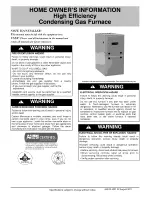
32
To convert to capacities at 15 psig settings—multiply by 1.13. To convert to capacities at 5 psig settings—multiply by 0.879.
Sizing Between Single or 2
nd
Stage Regulator and Appliance*
Maximum Propane Capacities Listed are Based on
¹⁄₂
" W.C. pressure drop at 11" W.C. setting. Capacities in 1,000 Btu/h.
Data in accordance with NFPA pamphlet Number 54.
CIRCULATING AIR AND FILTERS
Ductwork—Airflow
■
Duct systems and register sizes must be properly designed
for the CFM and external static pressure rating of the furnace.
Design the ductwork in accordance with the recommended
methods of “Air Conditioning Contractors of America”
Manual D.
■
Install the duct system in accordance with Standards of the
National Board of Fire Underwriters for the Installation of Air
Conditioning, Warm Air Heating and Ventilating Systems.
Pamphlets No. 90A and 90B.
■
A closed return duct system must be used, with the return
duct connected to the furnace.
NOTE: Ductwork must never be attached to the back of the
furnace.
■
Flexible joints may be used for supply and return connections
to reduce noise transmission.
■
To prevent the blower from interfering with combustion air or
draft when a central return is used, a connecting duct must
be installed between the unit and the utility room wall.
■
Never use a room, closet or alcove as a return air chamber.
When the furnace is used in connection with a cooling unit, the
furnace should be installed in parallel with or on the upstream
side of the cooling unit to avoid condensation in the heating
element.
With a parallel flow arrangement, the dampers or other means
used to control the flow of air must be adequate to prevent
chilled air from entering the furnace and, if manually operated,
must be equipped with means to prevent operation of either unit
unless the damper is in the full heat or cool position.
When the furnace is installed without a cooling coil, it is
recommended that a removable access panel be provided in the
outlet air duct. This opening shall be accessible when the furnace
is installed and shall be of such a size that the heat exchanger
can be viewed for visual light inspection or such that a sampling
probe can be inserted into the airstream. The access panel must
be made to prevent air leaks when the furnace is in operation.
When the furnace is heating, the temperature of the return air
entering the furnace must be between 55°F and 100°F (13ºC and
38ºC).
150 (45.7)
190
430
830
1,300
2,100
830
1,900
175 (53.3)
170
400
780
1,200
1,900
770
1,700
200 (61)
160
380
730
1,100
1,800
720
1,500
Propane Gas Piping Chart II
Tubing Size, O.D. Type L
Nominal Pipe Size Schedule 40
Pipe or Tubing Length—ft (m)
³⁄₈
"
¹⁄₂
"
⁵⁄₈
"
³⁄₄
"
⁷⁄₈
"
1
¹⁄₈
¹⁄₂
"
³⁄₄
"
1"
1
¹⁄₄
"
1
¹⁄₂
"
10 (3)
39
92
199
329
501
935
275
567
1,071
2,205
3,307
20 (6.1)
26
62
131
216
346
630
189
393
732
1,496
2,299
30 (9.2)
21
50
107
181
277
500
152
315
590
1,212
1,858
40 (12.2)
19
41
90
145
233
427
129
267
504
1,039
1,559
50 (15.2)
18
37
79
131
198
376
114
237
448
913
1,417
60 (18.3)
16
35
72
121
187
340
103
217
409
834
1,275
80 (24.4)
13
29
62
104
155
289
89
185
346
724
1,066
100 (30.5)
11
26
55
90
138
255
78
162
307
630
976
125 (38.1)
10
24
48
81
122
224
69
146
275
567
866
150 (45.7)
9
21
43
72
109
202
63
132
252
511
787
200 (61)
8
19
39
66
100
187
54
112
209
439
665
250 (76.2)
8
17
36
60
93
172
48
100
185
390
590
Propane Gas Piping Chart I
Tubing Size, O.D. Type L
Nominal Pipe Size Schedule 40
Pipe or Tubing Length—ft (m)
³⁄₈
"
¹⁄₂
"
⁵⁄₈
"
³⁄₄
"
⁷⁄₈
"
¹⁄₂
"
³⁄₄
"








































